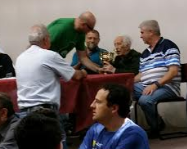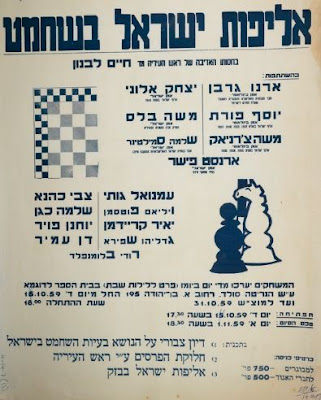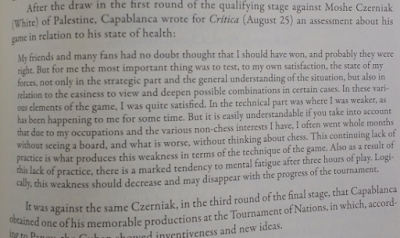 |
| Source: See Below |
In the previous post, we mentioned 'The Toys' (הצעצועים -
Ha'Tza'a'tzu'im) as an article mentioned in
Marmorosh's chess column. Thanks to the Israeli National Library's
online archive, the source was found. It is by
Yehoshua Reichenzahn (phonetic translation from the Yiddish
יהושע רייצעםזאהן)
and is found in the yearbook
Knesset Israel, 2nd year (1887), columns 47-64 (each page has two columns) of the 'Useful Section' (
Ha'Helek Ha'Shimushi, החלק השימושי) -- the sixth and last part of the yearbook, following the fifth part, the obituaries (p. 1340 on the online scanned version in the link).
The article starts with a very loose translation of chess terms from other languages into Hebrew, relying often on the sound of the word and not its meaning. While some translations make sense (e.g., 'horse' for the knight), he translates the German
Bauer (lit. "farmer", i.e., the pawn) as
Bor (בור) -- citing the source, the
Avoth tractate, where the word (as in modern Hebrew) means 'a hole in the ground', esp. one for keeping water. He also translates Rook as
Rach from another Talmudic tractate (
Bava Batra) where the word, again as in modern Hebrew, means 'soft' or 'young'.
The main part of the article is a poem,
Tachsisey Milchama (תכסיסי מלחמה, 'Strategy') of a battle between the Indian and Persian kings, who are doing battle against each other supported by a mercenary battalion of 'Germans' (the White pieces) or 'Africans' (the Black pieces), respectively. After each move by either side there is a four-line quatrain describing the move, its purpose, what it threatens, etc., ending with White checkmating the Persian king on, in modern notation, the 25th move (the 45th half-move). In this, the poem reminds one of
Jacob Eichenbaum's
Ha'Krav (הקרב, 'The Battle') (Odessa, 1839 -- see
Keats'
Chess in Jewish History and Hebrew Literature, Magnes Press, Jerusalem, 1995, pp. 232ff).
Apart from this, the article has chess problems ('The German [White] wins in one move', for example) and another game, this time between Zechariah, a Jewish merchant, and 'The Master', a gentile nobleman. who meet in a tavern. The game is given, as well as the conversation between the two. Zechariah, of course, wins, but The Master declares that he cheated and has his servants beat him. In a combination of remorse and shame, The Master ambushes Zechariah in the field as he leaves town, kills him, then shoots himself!
The article seems very obscure. It is not mentioned in Keats, nor have I found it anywhere else except for its mention in the introduction before the start of Marmorosh's first chess column (see previous post). As this introduction refers to Marmorosh in the third person as the 'player who will edit the column', it was probably not written by Marmorosh himself. One wonders who was the scholar who wrote the introduction, mentioning this obscure source as well as others.










































